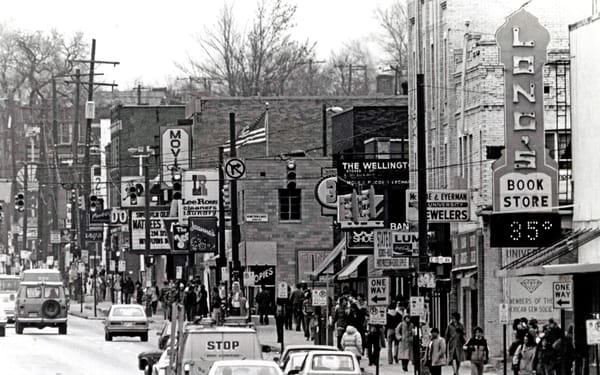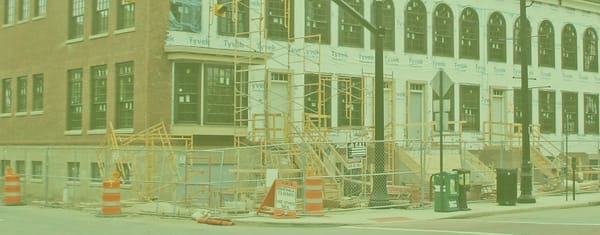💊 Another dose of housing thoughts for you
And an upcoming 'Snob Zoning' event! 👃🏡

Housing policy reform is in the autumn air 🍂
Cities around the country are taking concrete steps to grapple with the housing crisis. For example, the city council in Austin, a city with just 46,515 more people than Columbus, voted to eliminate parking minimums for nearly all projects citywide—including residential development. In Buffalo, there’s now a moratorium on new short-term rentals (STRs) related to myriad concerns, like how STRs are “exacerbating the affordable housing crisis” by taking thousands of long-term units out of the city’s housing stock. Other cities, like New Orleans and Dallas, are in the process of weighing STR regulations.
It’s clear that communities are demanding wide-ranging solutions to chip away at our historic undersupply of housing.
Because the policies to address the crisis are so diverse, housing advocates are well-positioned to create a strong coalition that centers the right to stable shelter over the right to exclude. What policy reforms are you most passionate about? Let us know and we might feature it in our next email!

Upcoming Event: Real-Life Lessons for Deconstructing Exclusionary Communities
Researcher and author Richard Kahlenberg is returning to Columbus to discuss his new book, Excluded: How Snob Zoning, NIMBYism, and Class Bias Build the Walls We Don't See. Hosted by Building Inclusive Communities, the evening will feature Kahlenberg and local panelists discussing solutions to the housing crisis.
When: Thursday, November 30 at 6:30 PM
Where: Canzani Center AuditoriumColumbus College of Art & Design
60 Cleveland Ave., Columbus, OH 43215Free Parking in the CCAD lots east and south of the Canzani Center
Kahlenberg will be joined by panelists Kumi Walker and Doug Ulman, Columbus residents who grew up together in Columbia, Maryland—a city designed to resist segregation. Through heartfelt accounts of families excluded from opportunity as they are hemmed in by “new redlining” that limits housing construction, Kahlenberg vividly illustrates why America has a housing crisis. Other noted guests will include Franklin County Treasurer Cheryl Brooks Sullivan, 10TV's Tracy Townsend, and former Columbus Mayor Michael Coleman.

New AHACO Report Released
A new report from the Affordable Housing Alliance of Central Ohio (AHACO) updates and expands 2017 research which previously found that 54,000 Franklin County households were severely cost burdened, paying more than half their income towards housing.
This new research finds that 80,000 households in the 15-county central Ohio region now face this severe housing cost burden. Moreover, local housing costs are increasing at the fastest pace in the region’s history. In fact, area home prices are growing three times faster than the median household income.
The report makes several recommendations, including:
- Increasing access to low-cost loans for affordable housing development
- Launching an eviction prevention system
- Adopting protections to reduce income discrimination
📚 The Book Beat

Glotzer, P. (2020). How the Suburbs Were Segregated: Developers and the Business of Exclusionary Housing, 1890–1960. Columbia University Press.
Today there’s growing discussion of housing as a financial investment, but the use of housing as a vehicle for investor profit is not a recent phenomenon. Roland Park, an early planned suburban community about four miles from downtown Baltimore, was backed by hundreds of individual British investors starting in 1891. Author Paige Glotzer reveals this planned community was “an outgrowth of the high degree of international financial integration” in the late nineteenth century (p. 6), and today it remains one of the premier residential sections of that region. Homes in the historic neighborhood regularly sell for more than $1 million, while the median price of a home in Baltimore City is just $175,300 (U.S. Census, 2021). Homes in early garden suburbs like this have, for the most part, greatly increased in value for more than a century.
In the 2020 book How the Suburbs Were Segregated: Developers and the Business of Exclusionary Housing, 1890–1960, historian Paige Glotzer explains how developers created neighborhoods that would resist physical or demographic evolution across time. Leveraging their personal networks to gain municipal benefits, developers relied on both private investment and public financing while excluding non-conforming populations (e.g., African Americans, Italians, Jews) from living in communities like Roland Park.
Her critical analysis of the deed restrictions and land use rules created by the Roland Park Company focus on “nuisance” as a “way of thinking about people and property together” (p. 47). Glotzer also notes how developers “shape tastes in housing” (p. 10) and—in the case of Roland Park—found it “necessary to educate Baltimoreans to ‘want more than brick walls and cobbled streets’ of the central city” (p. 56). The developers portrayed Baltimore’s core as “a place of disorder, sickness, and loss,” capitalizing on very real public health concerns of sanitation and disease of the period (p. 59).
Another aspect Glotzer examines is the close relationships among New Deal-era institutions, like the Home Owners’ Loan Corporation and Federal Housing Administration, and professional real estate associations—primarily the National Association of Real Estate Boards (NAREB), known today as the National Association of Realtors (NAR). To determine their appraisal process, the HOLC looked to NAREB principles. This relationship highlights how public policy has been shaped by private interests and industry groups to create a real estate system more beneficial to agent commissions and property valuations than principles of housing equity, access, and stability.
🗞️ Here are your links 🏘
Land Value Tax Proposal in Detroit 💰
The City of Detroit is pursuing the adoption of a Land Value Tax, an alternative way to tax land that re-balances tax burden toward unproductive and vacant land.
- Opinion: Property tax burden falls on owners of occupied homes in good condition
16 October 2023, Detroit Free Press - Lawmakers debate Detroit property tax plan
11 October 2023, Axios - Detroit wants to be the first big American city to tax land value5 October 2023, The Economist
Local + Regional 🌳
- Columbus suburbs: Hilliard elects supporters of denser growth, Gahanna outs attorney
7 November 2023, The Columbus Dispatch - How much you pay to buy or sell a home may be about to change. Here's what you need to know
3 November 2023, USA Today - Report: Improving affordable housing in Columbus could add years to lives of poorest
24 October 2023, The Columbus Dispatch - Housing density, growth among top issues facing Franklin County suburban candidates16 October 2023, The Columbus Dispatch
- Central Ohio needs more homes, so why aren't we seeing them?
15 October 2023, The Columbus Dispatch - Franklin County Auditor addresses property values, taxes, levies and being 'house poor'
28 September 2023, The Columbus Dispatch
National 🇺🇸
Impact of out-of-state landlords on affordable housing in Ohio
1 November 2023, Spectrum News 1Major landlords, RealPage sued in DC for alleged rent-fixing scheme
1 November 2023, CNBCHome Sellers Win $1.8 Billion After Jury Finds Conspiracy Among Realtors
31 October 2023, The New York TimesA New White House Plan to Create Affordable Housing: Convert Empty Office Buildings
27 October 2023, CityLab BloombergHow Landlord Tech Is Squeezing Renters Who Can't Afford Security Deposits
23 October 2023, ViceCan SLC entice building of more ‘missing middle’ homes to help ease its housing shortage?
15 October 2023, The Sale Lake TribuneKey excerpt: “With regard to parking, [Planning Director] Norris said the city faced ‘a value judgement on whether we want to require more cars or allow more homes. We chose to allow more homes’.”




